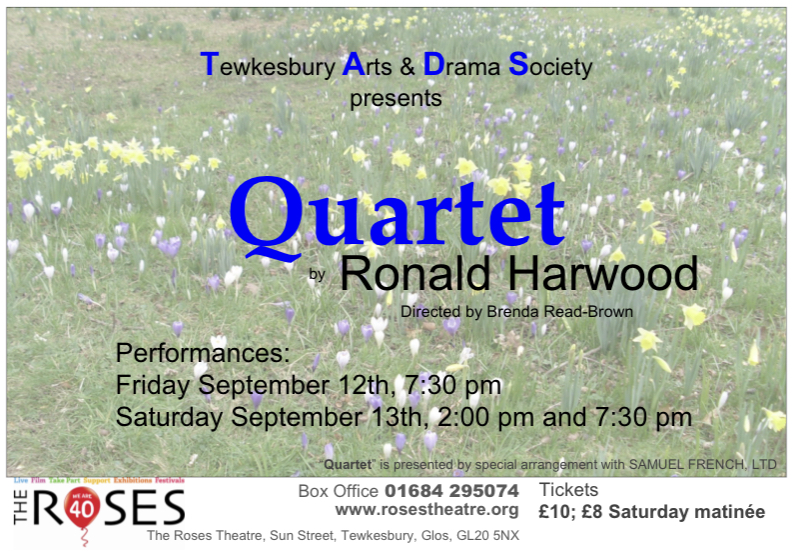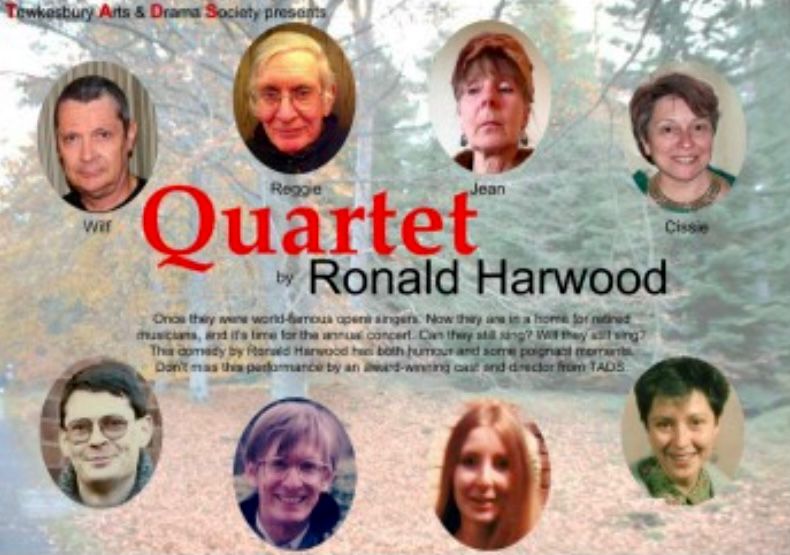



Once they were world-famous opera singers. Now they are in a home for retired musicians, and it’s time for the annual concert. Can they still sing? Will they still sing?
This comedy by Ronald Harwood had both humour and poignant moments.

What fun this was! A brilliant script, wonderful cast, sensitively directed, an absolute joy…. I could go on.
Louise Toft as Cissy
Growing old, memories, regrets, sadness, swearing, living in a care home. It’s a bloody comedy!
Jane Hughes as Jean
Lead the way, I’m ready for my tea and cake.
GoDA Full Adjudication:
The Play – Quartet
Ronald Harwood knows his theatre history. In the 1950’s he worked with the last of the great Actor/Managers, Sir Donald Wolfitt, in his company as actor and dresser, the experience of which formed the material for what many consider to be his most accomplished play, ‘The Dresser’. Later he produced a book and a weekly television series on the history of Theatre both called ‘All the World’s a Stage’, the final chapter and episode of which considered the second half of the twentieth century as the Age of the Musical. The larger than life figure of Sir Donald Wolfitt, the glitz, glamour and expertise of Musical Theatre and his involvement as theatre performer and technician combine to suggest why Mr Harwood was attracted to the world of Opera and why he approaches this material from a retrospective, nostalgic perspective. According to the play reviewer Sheridan Morley the play ‘Quartet’ starts with “something sad to say about growing old’ but becomes ‘sidetracked into a sort of Three Tenors concert celebration without the Three Tenors.’ The original cast included Donald Sinden, who sadly passed away last weekend, in a part that transferred to the screen played by Billy Connolly. Both of these actors are known for their larger than life performing styles and their co-cast members included Dame Maggie Smith, Stephanie Cole, Alec McCowan and Tom Courtney, all richly experienced thespians. It is clear what attracted them to this bittersweet play, focusing on a sister art to their own with such wonderfully honed lines from this master of dialogue. The four characters are cultural dinosaurs who trade recollections, witticisms and sentiments in a script that prises open old wounds and relationships. To succeed with this play a company requires a secure theatrical context and ‘four feisty old troupers’ so-called by Paul Taylor of The Independent. Unfortunately TADS did not ratchet the performances into this level of expertise which reduced the spectacle and ultimately the dramatic impact of the play but they did respond to the dialogue effectively at times, choosing a more naturalistic perspective.
The set
The single location required for the play is the music room and terrace of a country house in Kent, a retirement home for musicians and singers. The action takes place in the music room which should have a piano, large mirror, screen and comfortable, if haphazardly organised, furniture. This effect was achieved by TADS with a series of four freestanding flats, painted light green, which framed the acting space and combined with the bamboo style chairs to give sense of this country retreat. The pictures of musical heavyweights were all large enough to be acknowledged yet small enough not to distract and set dressing was economical, although the potted bloom needed more thought, as the play covers four months between June and October. If the blooming plant had been replaced with a withered stalk or a different plant for Act 2 Scene 2 the passage of time might have been subtly marked but the single bloom should not have stayed throughout the play. The trellis stage left worked well, the same style as the up stage flats, angled to allow Reggie to erupt towards the unseen ‘Bloody Angelique’. The setting of the furniture created a semi circle of space within which most of the movement took place but this also drew the actors too often to seated positions which did not engage the audience’s collective eye as much as more interesting use of a ‘haphazard’ organisation of furniture might have done. Nevertheless the set did fulfill the needs of the play quite well.
Costumes
There did not appear to be an overall unified style applied to costume. Reggie looked appropriately faded-debonaire in his pale colored jacket, while there was something of Cissie’s dippiness in the way her pink jacket and floral skirt were set off with blue pumps. Jean’s stylish black top and large patterned skirt were fine symbols of her classiness and each of them had an appropriate item of night clothing. However Wilf’s costume presented a problem as his green tee-shirt did not really seem appropriate for either the character’s age or extravagant character, while the wording on his chest was just a distraction. This problem was compounded by the fact that he wore the same shirt for the four months duration of the play, even under his dressing gown and later under his stage costume. The performance costumes they applied near the end were much better and did give a sense of their characters but the basket needed to be fuller and/or bigger as Reggie clearly handled the same costume a number of times before he ‘found’ it.
Lighting/sound
The stage was lit appropriately with the acting area fully illuminated. No appreciation of the light source through the french windows was apparent, but on the positive side there were also no distracting shadows. Sound cues seemed fine, although the audience applause at the end appeared to be recorded from a much larger audience than that for the recorded laughter and also the size suggested by the presence of Bobby in our audience. One factor over which TADS might have little influence was the setting of the technicians at the back of the stalls. This is beneficial for them in many ways but there were distincly audible voices heard from them at a number of moments in the play and occasional extraneous sounds over the sound system
Production
The play has a dramatic arc that begins in relative stillness, moves through the ebb and flow of banter and recriminations to the excitement of impending revelation. It is important that the tranquil atmosphere is established at the start. Cissie sits silently emersed in her music and Reggie sits reading and annotating his book, a picture of peace and contentment that could have been extended before Wilf’s entrance and again before his opening remark. The audience will then have time to acclimatise to the serenity enjoyed by the ‘inmates’ which is about to be shattered by the introduction of Jean Horton. Even when Wilf enters there are stage directions for silent interaction before his first line but everything happened rather too quickly at the start of this performance.
The opening scenes establish the second childhood of these aging cohabitees, Wilf the class clown taunting Cissie, whose concentration drifts in and out of coherence, while Reggie’s sobriety is punctuated by sudden explosions of marmalade fixated ire. These are character portraits that need to be fostered and fashioned into credible personalities with whom the audience will wish to spend the following two hours. During this section it was clear that the cast understood where the jokes were, delivering them with often good timing, but what was missing was a sense of their communion as companions reaching back at least three decades. The words were accurate but the character relationships needed more preparatory work for their situation to be believable. The early interactions were quite static physically and gestures were dominated by those specifically text related. It is true that they are over 70s but that does not justify inaction, rather it raises the directorial challenge to make the scene visually engaging.
The prospect of Jean’s entrance raised the dramatic tension a little but, with Reggie required to turn his back and sulk, the dramatic intensity needed to be charged by the other three. Actually the pace and tension was allowed to sag to a point where audibility became an issue. It became apparent that the cast needed some relative context for their position in the group and one way of achieving this would have been to do some off text work in rehearsal, wherein the characters have opportunities to explore their status and relationships. Without this the scene after Jean’s appearance became a little flat and rather uninteresting as words rather than dialogue were delivered. Good pace is not defined by increased speed but by variation and reaction through the actors’ skills of pause, silence, pitch, gesture, movement and facial expression. The director then must sustain the pulse of the play, synchronising the individual input of actors, designers and technicians. The play is heavy on dialogue so it is important to maintain audience interest by juxtaposing different tempi and rhythms in the vocal delivery of the actors. There is always a drift in this type of play for actors to slip into a regular pace adopting the pitch and pace of the preceding speaker and this happened on a number of occasions in this production. Much better was a later scene when two conversations operated either side of a screen. Here there was variation, and dramatic interest increased as a result. This was also a scene where stage business was introduced, with actors applying make up and costumes, and this dramatically improved the impact of the play. The final scene is really challenging for a director as the cast are required to perform a mimed song in real time. This is daunting because audience interest can wane and there might be a temptation to play for l laughs. This was not the case in this production but the scene would have benefitted from tighter choreography, each member of the quartet clearly inhabiting an identified voice, standing appropriate to their role in the group and miming totally accurately. The group did mime well but there needed to be more sense of group and of performance for it to truly convince. This is a very hard play to get right and it is to TADS credit that the main criticism is of dramatic tone and intensity rather than line accuracy and technical mistakes.
Acting
Cecily Robson played by Louise Toft
Louise had a brightness in her delivery most of the time that was accompanied by a bubbling chuckle. She handled the ‘senior moments’ well, twining one foot behind the other as she twisted her hair round her finger like a young schoolgirl. There was little sense of advanced age to her performance in truth, which may not have been a problem if others in the cast were not playing so much older than her. There were times when she injected some vivacity into the proceedings but she did yield to the collective pace at times. During ensemble sections she could disappear a little, with a reduction in drive and volume. She demonstrated that she has a good understanding of her character, producing an eccentric jig that suggested a characterisation which had potential for exploration.
Reginald Paget played by Geoff Guy
Geoff established early on his ability to listen and respond; he clearly understood the nature of the humorous lines that he had and delivered the punchlines with effective timing. The zero to a hundred mph shift and back again with the marmalade outbursts almost worked but there was a bit too much irony in his delivery and archness-for-effect in his return to the room. He handled the reactions to both Jean’s impending and her actual arrival with a good range of vocal, physical and facial skills. Again this performance was less effective in the seated ensemble sections but there was a good attempt at his artistic hubris.
Wilfred Bond played by Alan Wollaston
Wilf is the wisecracking heart of the quartet, his lascivious comments about Cissie masking a more complicated view of human relationships. Alan was good at uncovering moments of sensitivity within the play, He has a good ear for dialogue and listens well but there needed to be much more volume and attack in his characterisation of Wilf, The duologue with Reggie just prior to Jean’s first appearance demonstrated the best aspects of this performance, revealing compassion for Reggie’s situation with the wry ‘Me? Sympathetic? Don’t know the meaning of the word.’ but this section also exposed some timidity in the performance at variance with the character of Wilf. The speech on growing old needed more work to fully impress and the subtlety between the stage direction ‘no response’ and ‘silence’ needed to be explored.
Jean Horton played by Jane Hughes
Before her first appearance Ronald Marwood cleverly indicates how each of the others feel about Jean through the reactions and insinuations expressed in their dialogue, leaving the detail of those past times to gradually filter through over the course of the play. Jane’s entry was a study in haughtiness, and she sustained this aloof demeanour as her central characterisation. She incorporated grand gestures and delivered sly emasculating rejoinders with some dry candour, ‘You took nine, I took twelve!’ Once again Jane was less impressive in the ensemble sections where she adopted a downbeat tone that infected the others with the result that these sections became too dour and lacking in sufficient dramatic impact. She also needed a little more practice with the walking stick to ascertain where the seat of her affliction was based, as the stick appeared to be a textual affectation rather than a necessary support for Jean’s mobility.
Bobby played by Geoff Matthews
Not so much a dramatic role but rather an oppressive off stage influence. The script suggests a disembodied voice but by representing him physically the character has the opportunity to heckle as part of the performance and the quartet are provided with a focus for their responses. Geoff was loud enough and with just the right hint of stroppiness, sensibly avoiding the overt campness that others might attempt.
Dramatic Achievement
The cast of this play possess good performing skills but they needed to be exaggerated beyond the naturalistic style that they adopted. ‘Quartet’ is a difficult play to pull off and the attractions of carefully honed dialogue need to be set against the sheer scale of the performances demanded in playing these characters. A society might be drawn to the play because they have highly demonstrative actors and, indeed, sections of the text could be used as acting masterclass exercises. A successful production of this play will engage the audience with heavyweight thespian performers who gradually reveal chinks of empathetic compassion and normality. This report began by mentioning other work by Ronald Harwood and particularly ‘The
Dresser’. When this play transferred to film the two roles were played by Tom Courtney and Albert Finney, both of whom were feted for their performance early in their careers of ‘Billy Liar’. The cast of TADS performance of ‘Quartet’ appeared to be working in the more naturalistic style of Billy Liar than in the heightened style of ‘The Dresser’
Alan M Hayes





